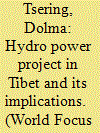| Srl | Item |
| 1 |
ID:
129859


|
|
|
|
|
| Publication |
New Delhi, Vij Books India Pvt Ltd, 2013.
|
| Description |
ix, 306p.Hbk
|
| Standard Number |
9789382573944
|
|
|
|
|
|
|
|
|
|
|
|
Copies: C:1/I:0,R:0,Q:0
Circulation
| Accession# | Call# | Current Location | Status | Policy | Location |
| 057704 | 333.79/PUM 057704 | Main | On Shelf | General | |
|
|
|
|
| 2 |
ID:
129661


|
|
|
|
|
| Publication |
2014.
|
| Summary/Abstract |
In contemporary international politics, the competition as well as cooperation between two most powerful countries: America and China have remained as a most interesting topic to be debate and discussed about. China rank second largest economy in the world and the kind of influences it spread across the world through its economic power are where most of the analyses of these debate and discussion lie on. Whether China's economic power will remain continues to grow or not depend on the source of its economic growth. In such case, apart from various other factors, energy production remained as one of the basic necessities. Therefore, China energy demands increased at an unprecedented level. In 2010, China became world's largest energy consumer by consuming 23 percent of total world energy consumption by overtaking the US position.
|
|
|
|
|
|
|
|
|
|
|
|
|
|
|
|
| 3 |
ID:
128023


|
|
|
|
|
| Publication |
2014.
|
| Summary/Abstract |
Niagara Falls and the Niagara River have always attracted great public interest due to their natural beauty, their enormous potential for electricity generation, their recreational value and as an important ecosystem. There have been simultaneous efforts to preserve this unique natural wonder and harness its power through hydroelectric development projects by both the United States and Canada. This paper explores the evolution of these efforts that culminated with the signing of the 1950 Niagara River Water Diversion Treaty that established minimum water flow rates to protect the "scenic beauty" of the falls, allowing the remaining water to be diverted for power production. We examine the rationale that led to specific water flow restrictions and question to what extent they are relevant today, as water intake capacity on the Canadian side has just been extended by around 25%. We find that current restrictions under the Niagara River Water Treaty (that expired in 2000) are not based on sound scientific evidence and estimate the upper limit of potential foregone benefits from clean electricity generation and greenhouse gas reductions. We identify a number of important issues that emerged in the last decades and that would justify an exploration of new treaty rules.
|
|
|
|
|
|
|
|
|
|
|
|
|
|
|
|